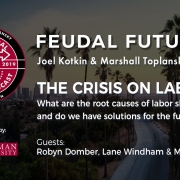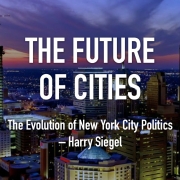The Next Entrepreneurial Revolution
The coronavirus pandemic has altered the future of American business. The virus-driven disruption has proved more profound than anything imagined by Silicon Valley, costing more jobs than in any year since the Great Depression. But there’s also good news, as Americans’ instinctive entrepreneurial spirit is driving growth and innovation: 4.4 million new business applications were recorded by census data in 2020, compared with roughly 3.5 million in 2019. Self-employment, pummeled at first, has recovered more rapidly than conventional salaried jobs, as more Americans reinvent themselves as entrepreneurs.
To be sure, the initial impact of the pandemic favored big chains and accelerated the already dangerous corporate concentration in technology—Amazon tripled its profits in the third quarter of 2020 and the top seven tech firms added $3.4 trillion in value last year. This in turn has made all business, as well as ordinary Americans, subject to manipulation by the handful of “platforms” that control the primary means of communication. Meanwhile, lockdowns drove an estimated 160,000 small businesses out of existence and left those that survived to face “an existential threat,” according to the Harvard Business Review.
Like pandemics of the past, the current one, according to Berkeley economists Laura Tyson and Jan Mischke, has already driven new investments in technology that could reverse the long-term decline in U.S. productivity. Low real estate prices could spark a return to street-level enterprise, even in places like Manhattan that have long been ultra-costly.
But the focus of opportunity is more likely to be found in the suburbs and exurbs, as well as in the middle of the country. The movement of populations away from the big urban centers started before COVID, but a recent study in CityLab notes that it has since accelerated in places like California’s Inland Empire, the Hudson Valley, and the New Jersey suburbs. Overall, according to demographer Wendell Cox, offices on the fringe have recovered far faster than those in the largest urban cores like Manhattan, San Francisco, Chicago, and Houston.
The geography of work has changed as well. Upward of 30% of those who plan to work remotely after the pandemic, notes a recent Upwork survey, plan to do so outside the house: in coffee houses, coworking spaces, or other office environments closer to home. This has created a new market for suburban office spaces, real estate investor Andrew Segal told me. He sees remote offices filling with workers who may be tired of working at home but do not want to go back to their long commutes. Segal has recently purchased properties in the suburban commuter sheds around Chicago, New York, Phoenix, and Colorado Springs. “The problem is called COVID, but it’s really about commuting,” suggested Segal, who is based in Houston. “People now know they can get their work done from somewhere else that’s easier to get to than Manhattan, downtown Houston, Chicago, or Los Angeles.”
Businesses are following the trend. Between September 2019 and September 2020, according to the firm American Communities and based on federal data, inner cities experienced nearly a 10% loss in jobs, while outer suburbs, exurbs, and rural areas fared far better. According to Jay Garner, president of Site Selectors Guild, companies are looking increasingly at smaller cities and even rural locations rather than in the big core cities. Indeed, seven of the top 10 midsize cities preferred for new investments include not just sunbelt boomtowns but heartland cities like Columbus, Des Moines, Indianapolis, and Kansas City.
Analysis by Zen Business this year found that the best places for small businesses in terms of taxes, survivability, and regulation were overwhelmingly in the South, parts of the Great Plains, Utah, and across the Midwest. Places like the Bay Area, New York, and Southern California crowded the bottom of the list. In some cities like San Francisco, even opening an ice cream shop has become subject to unendurable, endless regulatory reviews. Many heartland cities are exploiting this opportunity, with some offering generous bonuses to telecommuters from the coasts.
Read the rest of this piece on Tablet Magazine.
Joel Kotkin is the author of The Coming of Neo-Feudalism: A Warning to the Global Middle Class. He is the Presidential Fellow in Urban Futures at Chapman University and Executive Director for Urban Reform Institute. Learn more at joelkotkin.com and follow him on Twitter @joelkotkin.
Homepage photo: G. Keith Hall via Wikimedia under CC 3.0 License.








 Anthony Quintano, used under CC 2.0 License
Anthony Quintano, used under CC 2.0 License